Scientific name (Common names): Manduca sexta (Tobacco hornworm, Carolina sphinx moth, Carolina hawkmoth, Goliath worm)
Scientific name (Common names): Manduza quinquemaculata (Tomato hornworm, five-spotted hawkmoth)
Description:
Tobacco hornworms and tomato hornworms have a large range that spans from southern Canada to the Caribbean. These species behave and look quite similar to each other. The easiest way to tell them apart as caterpillars is to look at their white markings. Tobacco hornworms have seven stripes across their bodies that look like “/” marks, while tomato hornworms have eight upside down “7s” across their bodies. The adults have a wingspan that can spread 3 to 5 inches, with five or six pairs of yellow or orange spots down their abdomen.
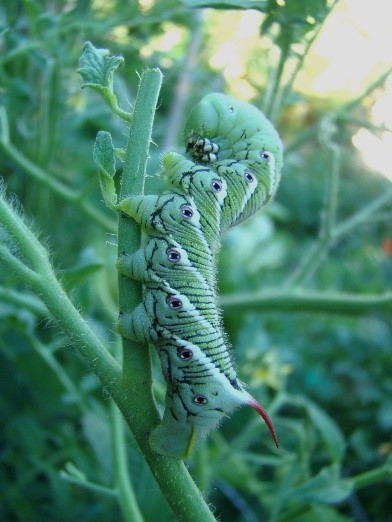 Tobacco hornworm on a tomato plant. Photo by Wendy Hanson Mazet.
Tobacco hornworm on a tomato plant. Photo by Wendy Hanson Mazet.
Behavior:
Adult moths resemble hummingbirds when feeding on nectar from plants and are sometimes mistakenly called hummingbird moths. Adults moths are most active at dawn and dusk. There is some evidence to show that these adult moths are important pollinators, which is a stark comparison to their ravenous caterpillar forms. Caterpillars are often found towards the top of plants and on the underside of the branches.
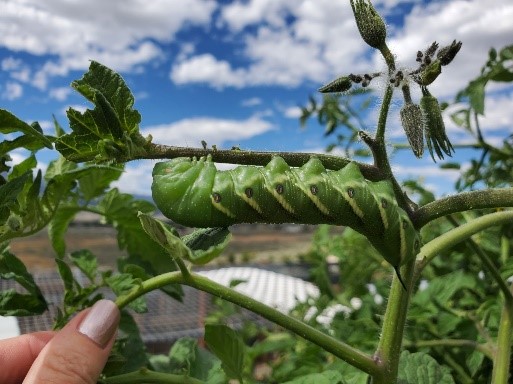 Tomato hornworm on tomato plant. Photo by Wendy Hanson Mazet.
Tomato hornworm on tomato plant. Photo by Wendy Hanson Mazet.
Life cycle:
Adults are first seen in spring after they have emerged from the soil where they overwintered as pupae. The adults will then lay one to five eggs on the underside of a leaf. These eggs will then hatch and become the gluttonous hornworms we know before burrowing into the soil again to repeat the cycle.
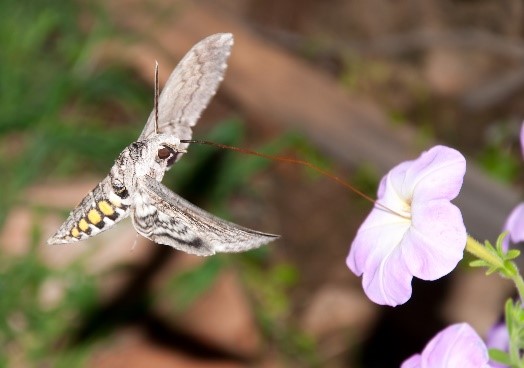 Adult tomato hornworm. Photo by pimmimemom, stock.adobe.com.
Adult tomato hornworm. Photo by pimmimemom, stock.adobe.com.
Diet and damage:
Both tobacco and tomato hornworms typically feed on solanaceous plants: tomatoes, eggplant, peppers, potatoes, and various other annuals and weeds. Two or three hornworms are capable of defoliating an entire plant. The hornworms typically will leave a plant stem completely bare, with the exception of the leaf veins. If there are no leaves left, hornworms have been known to eat the fruit off plants too. This damage looks similar to bird damage.
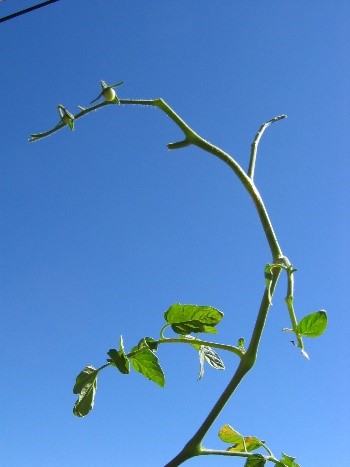 Damage caused to a tomato plant by a tomato hornworm. Photo by Wendy Hanson Mazet.
Damage caused to a tomato plant by a tomato hornworm. Photo by Wendy Hanson Mazet.
Monitoring:
Searching through your plants for damage, frass (insect excrement), eggs and caterpillars on a daily basis will allow for control before serious issues occur. Frass for these species is very distinctive with a green color that turns to black as it dries. Help with identification is available by contacting your local Extension office.
Cultural control:
Rotating crops that are less susceptible to hornworm attacks can help keep populations low. Tilling soil can also be beneficial, as it will disturb the pupae that are overwintering under it. This should be done in the fall or early spring.
Mechanical control:
Hand picking and eradicating the caterpillars and egg patches off the plants is one of the most effective ways to prevent population growth. The caterpillars have great camouflage during the day; however, with use of a UV light at night, the hornworms glow, making them easier to locate and pick off plants.
Biological control:
There are several naturally occurring parasites that help control hornworms. As an example, parasitic wasps, commonly found in gardens, attack hornworms. The wasp lays its eggs inside the caterpillar, which then feed on the caterpillar and develop cocoons that look like grains of rice on the outside of the caterpillar. When removing hornworms from your garden, it is a good idea to leave behind any that have been parasitized to help support the parasitic wasp population. Some gardeners will tolerate small numbers of hornworms, as they can help with pruning plants.
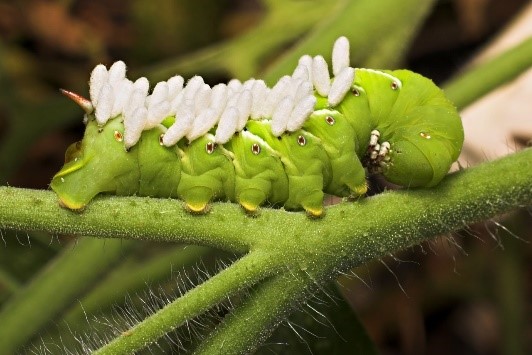 Tobacco hornworm that has been parasitized by a wasp. Photo by dougsmit, pixabay.com.
Tobacco hornworm that has been parasitized by a wasp. Photo by dougsmit, pixabay.com.
Chemical control:
Spraying pesticides to control hornworms could increase the risk of aphid population explosions, as the pesticides can accidentally kill beneficial insects that eat the aphids. Bt (Bacillus thuringiensis) is a biological pesticide that can be used as an alternative to chemical pesticides. When applying a pesticide, read the entire product label thoroughly before application.


